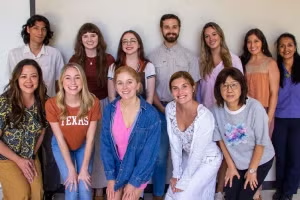“Discovering the Language of Photography: The Gernsheim Collection,” an exhibition at the Harry Ransom Center, explores the history of photography through the center’s foundational photography collection.

The exhibition runs from Sept. 7, 2010, to Jan. 2, 2011, at the Ransom Center, a humanities research library and museum at The University of Texas at Austin.
Featuring more than 175 items, the exhibition showcases one of the seminal collections of the history of photography in the United States. Amassed by the renowned husband-and-wife team of Helmut and Alison Gernsheim between 1945 and 1963, it contains an unparalleled range of more than 35,000 images, beginning with the world’s earliest-known photograph from nature, made by Joseph Nicéphore Niépce in 1826-27. Its encyclopedic scope — as well as the expertise with which the Gernsheims assembled the collection — makes the Gernsheim collection one of the world’s premier sources for the study and appreciation of photography.
The university purchased the Gernsheim collection in 1963.
“The Helmut and Alison Gernsheim collection is one of the finest collections of photography built upon the foundation of the medium’s history,” said David Coleman, curator of photography at the Ransom Center. “While the Gernsheims assembled a peerless collection with many masterpieces by major photographers, they were also fascinated by the intersection of expanding artistic principles and technological improvements in image making.”
Along with photographs from the collection, the exhibition includes equipment, albums, correspondence and other manuscript materials that illustrate a visual history of photography from the earliest-known photograph to images of the mid-20th century. Also included are some of the 30 photography books the Gernsheims authored.
The exhibition is made up of two complementary and interweaving narratives — the history of photography as told through the collection’s imagery and the history of the collection’s formation and methodology.
While a substantial portion of the Gernsheim collection focuses on 19th-century British photography by artists such as Lewis Carroll, Julia Margaret Cameron, Roger Fenton, Henry Peach Robinson, and David Hill and Robert Adamson, several of the collection’s works by unknown or lesser-known artists who used various means to improve or to exploit the relatively new invention of photography will also be displayed. The exhibition will highlight key moments in the history of photography as well as important technological and ideological shifts in the act of picture making.

To coincide with the exhibition, UT Press is publishing a catalog of the exhibition, “The Gernsheim Collection.” The book includes more than 125 full-page plates from the collection accompanied by extensive annotations in which the Ransom Center’s senior research curator Roy Flukinger describes each image’s place in the evolution of photography and within the collection. The catalog also traces the Gernsheims’ passion for collecting and their career as pioneering historians of photography, showing how their efforts significantly contributed to the acceptance of photography as a fine art and as a field worthy of intellectual study. The book also includes a foreword by George Eastman House Curator of Photographs Alison Nordström and an afterword by former Victoria and Albert Museum Curator Mark Haworth-Booth.
“Discovering the Language of Photography” can be seen in the Ransom Center Galleries on Tuesdays through Fridays from 10 a.m. to 5 p.m., with extended Thursday hours until 7 p.m. On Saturdays and Sundays the galleries are open from noon to 5 p.m. The galleries are closed on Mondays.
High-resolution press images from the exhibition are available.



